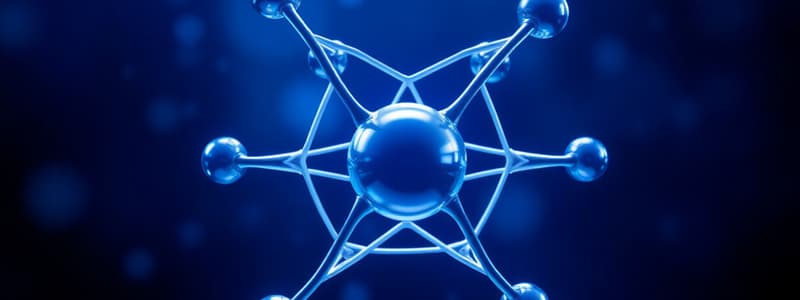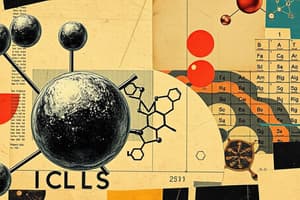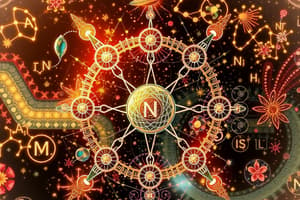Podcast
Questions and Answers
What is the maximum number of electrons that can occupy the third electron shell?
What is the maximum number of electrons that can occupy the third electron shell?
- 18 (correct)
- 2
- 32
- 8
Which statement accurately describes a compound?
Which statement accurately describes a compound?
- It is listed in the Periodic Table.
- It contains two or more different types of atoms bonded together. (correct)
- It consists of only one type of atom.
- It can be separated by physical means.
What is the atomic mass of an element based on?
What is the atomic mass of an element based on?
- The total number of protons and neutrons. (correct)
- The total number of neutrons only.
- The number of protons only.
- The total number of protons and electrons.
In a mixture, what can be said about its components?
In a mixture, what can be said about its components?
What best describes an element?
What best describes an element?
What is the primary role of producers in an ecosystem?
What is the primary role of producers in an ecosystem?
Which statement accurately describes the flow of energy in food chains?
Which statement accurately describes the flow of energy in food chains?
What is the correct description of decomposers?
What is the correct description of decomposers?
What type of consumer only eats plants?
What type of consumer only eats plants?
Which of the following best illustrates the concept of energy flow in a food chain?
Which of the following best illustrates the concept of energy flow in a food chain?
Why are food chains typically short with only a few steps?
Why are food chains typically short with only a few steps?
Which process describes how plants convert carbon dioxide and water into sugars?
Which process describes how plants convert carbon dioxide and water into sugars?
Which of the following best defines omnivores?
Which of the following best defines omnivores?
Which of the following is the correct way to represent the balancing of HgO → Hg + O2?
Which of the following is the correct way to represent the balancing of HgO → Hg + O2?
What is the coefficient for HCl in the balanced equation BaCl2 + H2SO4 → BaSO4 + HCl?
What is the coefficient for HCl in the balanced equation BaCl2 + H2SO4 → BaSO4 + HCl?
In the chemical formula C2H6, how many hydrogen atoms are present?
In the chemical formula C2H6, how many hydrogen atoms are present?
Which formula represents the correct ratio of Na to Br in the balanced equation Cl2 + 2NaBr → 2NaCl + Br2?
Which formula represents the correct ratio of Na to Br in the balanced equation Cl2 + 2NaBr → 2NaCl + Br2?
How many total hydrogen atoms are present in the formula 3 Al(OH)3?
How many total hydrogen atoms are present in the formula 3 Al(OH)3?
What is the balanced coefficient for magnesium in the equation Mg + O2 → MgO?
What is the balanced coefficient for magnesium in the equation Mg + O2 → MgO?
Why should you balance hydrogen and oxygen atoms last when balancing chemical equations?
Why should you balance hydrogen and oxygen atoms last when balancing chemical equations?
What does a subscript in a chemical formula indicate?
What does a subscript in a chemical formula indicate?
How do you know that the equation Fe + O2 → Fe2O3 is not balanced?
How do you know that the equation Fe + O2 → Fe2O3 is not balanced?
What is the main objective when you balance a chemical equation?
What is the main objective when you balance a chemical equation?
Which of the following describes coefficients in a chemical equation?
Which of the following describes coefficients in a chemical equation?
What does the conservation of mass principle state in a chemical reaction?
What does the conservation of mass principle state in a chemical reaction?
Given the unbalanced equation Fe + O2 → Fe2O3, what is the correct coefficient for Fe to start balancing?
Given the unbalanced equation Fe + O2 → Fe2O3, what is the correct coefficient for Fe to start balancing?
After balancing iron in the equation 4 Fe + O2 → 2 Fe2O3, how many oxygen atoms are present on the product side?
After balancing iron in the equation 4 Fe + O2 → 2 Fe2O3, how many oxygen atoms are present on the product side?
What is the final balanced equation for the reaction involving iron and oxygen?
What is the final balanced equation for the reaction involving iron and oxygen?
What is a characteristic of the final balanced equation concerning coefficients?
What is a characteristic of the final balanced equation concerning coefficients?
Which of the following is true about balancing equations for charge and mass?
Which of the following is true about balancing equations for charge and mass?
What are the three main components of an ecosystem?
What are the three main components of an ecosystem?
Which of the following best describes intraspecific competition?
Which of the following best describes intraspecific competition?
What term describes the relationship where one organism benefits while the other is unaffected?
What term describes the relationship where one organism benefits while the other is unaffected?
Which factor is classified as abiotic?
Which factor is classified as abiotic?
What is mutualism?
What is mutualism?
What is an example of interspecific competition?
What is an example of interspecific competition?
Which of the following describes parasitism?
Which of the following describes parasitism?
What is true about the sustainability of natural ecosystems?
What is true about the sustainability of natural ecosystems?
What is one primary factor that affects the stability of an ecosystem?
What is one primary factor that affects the stability of an ecosystem?
Which type of ecosystem is characterized by high levels of biodiversity and significant resource cycling?
Which type of ecosystem is characterized by high levels of biodiversity and significant resource cycling?
How do natural disturbances impact ecosystems?
How do natural disturbances impact ecosystems?
Which statement best reflects the relationship between species adaptations and ecosystem characteristics?
Which statement best reflects the relationship between species adaptations and ecosystem characteristics?
Which human activity is known to significantly disturb ecosystems?
Which human activity is known to significantly disturb ecosystems?
Which of the following best describes the role of consumers in an ecosystem?
Which of the following best describes the role of consumers in an ecosystem?
What is a key difference between abiotic and biotic factors in ecosystems?
What is a key difference between abiotic and biotic factors in ecosystems?
How does energy flow through an ecosystem?
How does energy flow through an ecosystem?
Which nutrient cycle is critical for returning essential elements to the ecosystem?
Which nutrient cycle is critical for returning essential elements to the ecosystem?
What can result from significant changes in abiotic factors within an ecosystem?
What can result from significant changes in abiotic factors within an ecosystem?
Which of the following is NOT considered an ecosystem service?
Which of the following is NOT considered an ecosystem service?
Which statement correctly describes the importance of biodiversity in ecosystems?
Which statement correctly describes the importance of biodiversity in ecosystems?
Which of the following accurately describes producers in an ecosystem?
Which of the following accurately describes producers in an ecosystem?
What is the balanced coefficient for hydrogen in the reaction $N_2 + H_2 \rightarrow NH_3$?
What is the balanced coefficient for hydrogen in the reaction $N_2 + H_2 \rightarrow NH_3$?
In the equation $Pb(OH)_2 + HCl \rightarrow H_2O + PbCl_2$, how many moles of water are produced?
In the equation $Pb(OH)_2 + HCl \rightarrow H_2O + PbCl_2$, how many moles of water are produced?
What is the balanced form of the combustion reaction $C_3H_8 + O_2 \rightarrow CO_2 + H_2O$?
What is the balanced form of the combustion reaction $C_3H_8 + O_2 \rightarrow CO_2 + H_2O$?
What is the correct coefficient for $Na$ when balancing the equation $Na + H_2O \rightarrow NaOH + H_2$?
What is the correct coefficient for $Na$ when balancing the equation $Na + H_2O \rightarrow NaOH + H_2$?
In the equation C₃H₈ + O₂ → CO₂ + H₂O, what is the correct coefficient for O₂ after balancing?
In the equation C₃H₈ + O₂ → CO₂ + H₂O, what is the correct coefficient for O₂ after balancing?
After balancing the equation NH₄NO₃ → N₂O + H₂O, how many H atoms are present on the product side?
After balancing the equation NH₄NO₃ → N₂O + H₂O, how many H atoms are present on the product side?
Which of the following can disrupt mutualistic relationships?
Which of the following can disrupt mutualistic relationships?
What is the primary characteristic of parasitism?
What is the primary characteristic of parasitism?
Which of the following options describes a mutualistic relationship?
Which of the following options describes a mutualistic relationship?
What is the primary reason energy transfer between trophic levels is inefficient?
What is the primary reason energy transfer between trophic levels is inefficient?
What is one consequence of the inefficiency of energy transfer in food webs?
What is one consequence of the inefficiency of energy transfer in food webs?
Which of the following describes the role of decomposers within a food web?
Which of the following describes the role of decomposers within a food web?
What distinguishes producers from consumers in an ecosystem?
What distinguishes producers from consumers in an ecosystem?
Which of the following describes the relationship between the number of trophic levels and the efficiency of energy transfer?
Which of the following describes the relationship between the number of trophic levels and the efficiency of energy transfer?
Which statement accurately describes the role of primary consumers in a food chain?
Which statement accurately describes the role of primary consumers in a food chain?
Which of the following best defines apex consumers in a food chain?
Which of the following best defines apex consumers in a food chain?
In which trophic level are primary consumers found?
In which trophic level are primary consumers found?
Which of the following accurately describes a tertiary consumer?
Which of the following accurately describes a tertiary consumer?
What is the function of decomposers in an ecosystem?
What is the function of decomposers in an ecosystem?
How are trophic levels defined within an ecological community?
How are trophic levels defined within an ecological community?
What best describes energy transfer within a food chain?
What best describes energy transfer within a food chain?
Which of the following statements is true regarding apex consumers?
Which of the following statements is true regarding apex consumers?
In a food web, what might be a consequence of removing a primary producer?
In a food web, what might be a consequence of removing a primary producer?
Study Notes
Chemistry Basics
-
Atoms are the smallest particles of matter.
-
Atoms consist of a nucleus and electron shells.
-
The nucleus contains protons (positive charge) and neutrons (neutral charge).
-
Electrons (negative charge) orbit the nucleus in shells.
-
Electron shells have maximum capacities:
- First shell = 2 electrons
- Second shell = 8 electrons
- Third shell = 18 electrons (stable at 8)
- Fourth shell = 32 electrons
-
Elements are made of the same type of atom.
-
Elements are listed on the Periodic Table ordered by atomic number (number of protons). Elements include hydrogen (H), carbon (C), nitrogen (N), silver (Ag), lead (Pb), mercury (Hg).
-
Each element has a symbol (e.g., Hydrogen - H, Carbon - C).
-
Molecules are formed when two or more atoms bond together.
-
Molecules of the same type of atom = molecule of element (e.g., O₂).
-
Molecules of different types of atoms = molecule of compound (e.g., CO₂).
-
Compounds are formed when two or more different types of atoms bond together.
-
Examples include water (H₂O), carbon dioxide (CO₂), methane (CH₄), glucose (C₆H₁₂O₆), Iron (Fe), Oxygen (O₂), Mercury (Hg), sodium (Na), chlorine (Cl₂), sodium bromide (NaBr), copper(II) chloride (CuCl₂)., hydrogen sulfide (H₂S), copper sulfide (CuS), hydrogen chloride (HCl), barium sulfate (BaSO₄), water (H₂O₂), nitrogen (N₂), ammonia (NH₃)., aluminum hydroxide(Al(OH)₃)., potassium chloride, potassium chlorate, sodium fluoride, potassium chlorate, aluminum bromide, potassium sulfate, potassium chlorate, potassium iodide.
-
Mixtures are combinations of atoms, elements, and compounds.
-
Mixtures may have varying amounts of each component.
-
Mixtures do not have a set formula.
Periodic Table
- A list of all known elements.
- Elements are listed in order of atomic number.
- Rows are called periods and columns are called groups.
- Metals are on the left side of the table, non-metals are on the right. Metalloids are the elements in between.
- The table provides information about each element, including:
- Atomic number
- Chemical symbol
- Element name
- Atomic mass
Balancing Chemical Equations
- Chemical equations show reactants (starting materials) and products (results of the reaction).
- Balanced equations show equal numbers of atoms of each element on both sides of the equation.
- Follow steps to balance equations:
- Write unbalanced equation.
- Count atoms of each element on each side.
- Add coefficients (numbers in front of formulas) as needed to balance each element. Start with the least manipulated element.
- Indicate the state of matter for each substance (s, l, g, aq).
Mixtures
- Mixtures can be separated by physical means.
- Examples of mixtures include: salt water, air, soft drinks, perfumes.
Ecosystem Interactions
-
Environment includes all living and non-living factors in an organism's surroundings.
-
Ecosystem: a group of living things interacting with their environment.
-
Ecosystem components:
- Physical surroundings (soil, water, rocks, light intensity, temperature, nutrients, concentration of gases in water, texture and pH of soil, etc.).
- Living organisms (community)
- Living and non-living factors (e.g. competition, predation).
-
Abiotic factors are non-living, while biotic factors are living.
-
Types of Symbiosis
- Mutualism: both species benefit (e.g., clownfish and anemone, oxpecker bird and antelope).
- Commensalism: one species benefits, the other is unaffected (e.g., barnacle on a whale, possum in tree hollow).
- Parasitism: one species benefits, the other is harmed (e.g., tick on a dog, parasitic wasp and caterpillar).
-
Ecosystems show sustainability when maintaining living conditions for the community is possible.
-
Organisms interact with each other and the environment, influencing the ecosystem.
Food Chains
- Energy flows from producers (e.g., plants) to consumers (e.g., herbivores, carnivores).
- Decomposers break down dead materials and cycle nutrients, so the ecosystem maintains sustainability.
- Food chains show energy flow and trophic levels (producers, primary consumers, secondary consumers, tertiary consumers, etc.).
- Pyramids of energy show the progressive loss of usable energy as you move up the trophic levels.
- Only about 10% of energy gets passed from one level to the next. This loss limits the number of organisms at each level.
- Pyramids of energy can display the total mass of organisms at each stage of a food chain thus showing the productivity of an area.
Studying That Suits You
Use AI to generate personalized quizzes and flashcards to suit your learning preferences.




